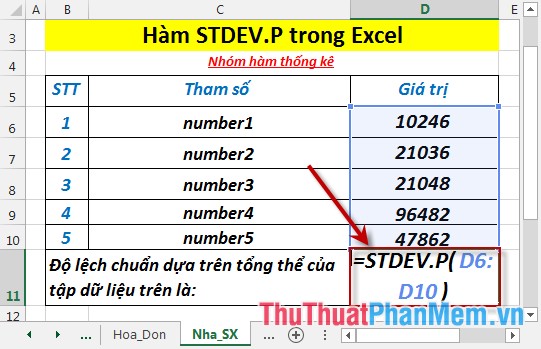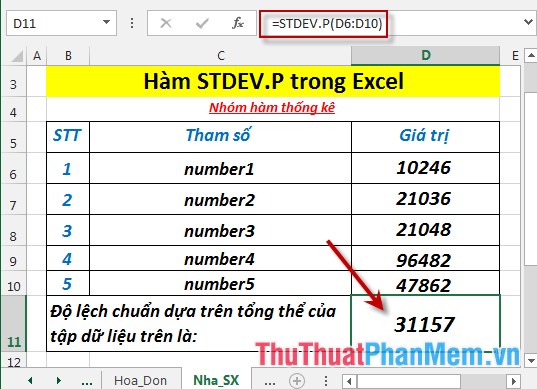STDEV.P function - The function returns the standard deviation based on the whole in Excel
The following article introduces you to the STDEV.P function - one of the functions in the group of statistical functions that is very popular in Excel.

Description: The function returns standard deviations based on the whole, ignoring logical values and text. Standard deviation is a measure of the dispersion of values against the mean. Support functions from Excel 2010 onwards.
Syntax: STDEV.P (number1, [number2], .)
Inside:
- number1, [number2], . : The values you want to calculate the standard deviation, where number1 is the required parameter, the remaining parameters are optional and contain up to 254 number parameters .
Attention:
- STDEV.P function assumes that its arguments are whole.
- For large sample sizes -> STDEV.S, STDEV.P returns the same value.
- Standard deviation calculated using the method 'n'.
- Arguments can be numbers, names or arrays that contain numbers.
- When typing logical values and presenting numeric values into function arguments -> these values are still calculated.
- Function error occurs when arguments are text or error values cannot be converted.
- If you want to calculate both logical values and text -> use STDEVPA function .
- Equation STDEV.P uses:
[sqrt {frac {{sum {{{left ({x - overline x} right)} ^ 2}}}} {n}}]
Inside:
+ x is the sample mean AVERAGE (number1, number2, .)
+ n is the sample size.
For example:
Calculate the standard deviation based on the totality of the values in the following data table:

- In the cell to calculate, enter the formula : = STDEV.P (D6: D10)

- Press Enter -> standard deviation based on overall is:

- Where the values of the elements in the set are text or logical values -> they are ignored:

Above are instructions and some specific examples when using the STDEV.P function in Excel.
Good luck!
You should read it
- NORM.S.DIST function - The function returns the normalized distribution with a mean of 0 and a standard deviation of 1 in Excel
- NORM.DIST function - The function returns the normal distribution with the standard deviation and the mean value specified in Excel
- NORM.S.INV function - The function returns the inverse of the normalized distribution with an average value of 0 and a standard deviation of 1 in Excel
- NORM.INV function - The function returns the inverse of the standard cumulative distribution in Excel
- SKEW function - The function returns the deviation of the distribution in Excel
- NORMDIST function - The function returns the normal distribution with the standard deviation and the average value specified in Excel
- LOGNORM.INV function - The function returns the inverse of the logarithmic distribution of x in Excel
- GUSSE function - The function returns the probability that an element of the population is normalized in Excel
May be interested
- LOGNORM.INV function - The function returns the inverse of the logarithmic distribution of x in Excel
 lognorm.inv: the function returns the inverse of the logarithmic distribution of x. where ln (x) is usually distributed with parameter mean and standard deviation. use functions to analyze logarithmic change data. support function from excel 2 version
lognorm.inv: the function returns the inverse of the logarithmic distribution of x. where ln (x) is usually distributed with parameter mean and standard deviation. use functions to analyze logarithmic change data. support function from excel 2 version - STDEVPA function - The function of estimating standard deviations based on an entire population including both text and logical values in Excel
 stdevpa function: the function of estimating standard deviation based on the whole population including both text and logical values. standard deviation is a measure of the dispersion of a value against the mean. syntax: stdevpa (value1, [value2], ...)
stdevpa function: the function of estimating standard deviation based on the whole population including both text and logical values. standard deviation is a measure of the dispersion of a value against the mean. syntax: stdevpa (value1, [value2], ...) - GUSSE function - The function returns the probability that an element of the population is normalized in Excel
 gusse function: the function returns the probability that an element of the normalized population will fall into the mean and the standard deviation. support functions from excel 2013 onwards. syntax: gauss (z)
gusse function: the function returns the probability that an element of the normalized population will fall into the mean and the standard deviation. support functions from excel 2013 onwards. syntax: gauss (z) - AVEDEV function - The function returns the average absolute deviation of data points from their midpoint in Excel
 avedev function: the function returns the average absolute deviation between a given data point and the average value of the population. the function is a measure of the variability of a dataset
avedev function: the function returns the average absolute deviation between a given data point and the average value of the population. the function is a measure of the variability of a dataset - LOGNORM.DIST - Function returns the logarithmic distribution of x in Excel
 lognorm.dist: the function returns the logarithmic distribution of x. where ln (x) is usually distributed with parameter mean and standard deviation. support functions from excel 2010 onwards. syntax: lognorm.dist (x, mean, standard_dev, cumulative)
lognorm.dist: the function returns the logarithmic distribution of x. where ln (x) is usually distributed with parameter mean and standard deviation. support functions from excel 2010 onwards. syntax: lognorm.dist (x, mean, standard_dev, cumulative) - How to use NORMDIST function in Excel
 normdist is a function that returns a distribution with a standard deviation and a confirmed average. the normdist function applies in statistics, including hypothesis testing.
normdist is a function that returns a distribution with a standard deviation and a confirmed average. the normdist function applies in statistics, including hypothesis testing. - FTEST function - The function returns the result of an F-Test in Excel
 the following article details how to use ftest - the function returns the result of an f-test. in statistical probability, the determination of the correctness and the deviation between two data samples is a regular and extremely important job.
the following article details how to use ftest - the function returns the result of an f-test. in statistical probability, the determination of the correctness and the deviation between two data samples is a regular and extremely important job. - STDEVA function - The function of estimating standard deviations based on a sample including both text and logical values in Excel
 stdeva function: the function of estimating standard deviations based on a sample including both text and logical values. standard deviation is a measure of the dispersion of a value against the mean. syntax: stdeva (value1, [value2], ...)
stdeva function: the function of estimating standard deviations based on a sample including both text and logical values. standard deviation is a measure of the dispersion of a value against the mean. syntax: stdeva (value1, [value2], ...) - DAYS360 function - The function returns the number of days between 2 dates, based on 360 days in Excel
 days360 function: the function performs the calculation of the number of days between 2 days, based on 360 days year (from 12 months, 30 days per month). useful function in calculating payments in the accounting system based on twelve months 30 days. syntax: days (start_date, end_date, [m
days360 function: the function performs the calculation of the number of days between 2 days, based on 360 days year (from 12 months, 30 days per month). useful function in calculating payments in the accounting system based on twelve months 30 days. syntax: days (start_date, end_date, [m - WEIBULL function - The function returns the Weibull distribution in Excel
 the function performs the calculation and returns the weibull distribution. based on this distribution to analyze reliability in theory such as calculating the average life of the device or used in the field of meteorology, hydrology and weather forecast.
the function performs the calculation and returns the weibull distribution. based on this distribution to analyze reliability in theory such as calculating the average life of the device or used in the field of meteorology, hydrology and weather forecast.










 STDEV.S function - The function returns the standard deviation based on a sample in Excel
STDEV.S function - The function returns the standard deviation based on a sample in Excel GAMMA.INV function - The function returns the inverse of the gamma distribution in Excel
GAMMA.INV function - The function returns the inverse of the gamma distribution in Excel GAMMALN function - The function returns the natural logarithm of the gamma function, Γ (x) in Excel
GAMMALN function - The function returns the natural logarithm of the gamma function, Γ (x) in Excel GAMMALN.PRECISE function - The function returns the natural logarithm of the gamma function, Γ (x) in Excel
GAMMALN.PRECISE function - The function returns the natural logarithm of the gamma function, Γ (x) in Excel GEOMEAN function - The function returns the average of a positive array or range of data in Excel
GEOMEAN function - The function returns the average of a positive array or range of data in Excel GROWTH function - The function calculates the exponential growth value using existing data in Excel
GROWTH function - The function calculates the exponential growth value using existing data in Excel